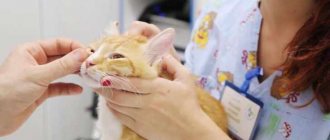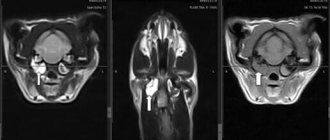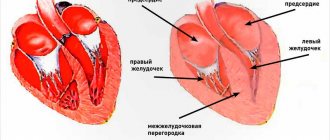Frequent cleaning is the least of the problems that arise when pets experience excessive hair loss. The causes of hair loss in cats are not always natural - sometimes the situation can be explained by a pathology that requires mandatory treatment. Owners can make a presumptive diagnosis based on accompanying symptoms. If you suspect skin or other diseases, you will need to contact a veterinarian.
Natural causes
Minor hair loss occurs when hair follicles die. Their life cycle consists of 3 phases:
- anagen
– the longest and most active growth phase;
- catagen
– regression phase, accompanied by the cessation of further growth;
- telogen
– a resting phase, which involves the separation and removal of the hair follicle to the surface of the skin.
Other natural causes of hair loss in cats depend on the time of year, quality of diet, stress level, age and physiological characteristics. If the coat does not undergo major changes, and the pet’s health remains satisfactory, then nothing threatens its life and health.
Shedding in season
Seasonal molting in adult animals occurs twice a year: in autumn and spring. Before winter, the undercoat is renewed and becomes thicker to protect the cat from the upcoming frosts. By spring, it begins to fall out again, but this time it thins out, returning to its original state.
Long-haired pets may shed more heavily. These cats lose their hair in small clumps.
An abundance of dead hair can lead to excessive accumulation of hairballs in the stomach and intestines. These days, give your mustachioed pet pastes that stimulate hair removal, or feed it grass. Also, do not forget about regular brushing and add more vitamins to the diet, but only after consulting a veterinarian.
Inappropriate diet
When feeding cheap food or an unbalanced natural diet, hair loss can lead to the formation of bald patches. This occurs due to a lack of vitamins responsible for the quality of the coat.
Experiences and stress
Under severe stress, a mustachioed pet often falls into apathy and refuses to eat. Abnormal bowel movements and vomiting are also possible. To understand the root cause, try to analyze recent events. Most often, animals worry because of a change in environment, the appearance of new family members and insufficient attention from the owner.
Elderly age
Older animals become bald around the face and ears. After 8 years, all metabolic processes slow down. The period of hair growth is also reduced - this is natural and does not require drug treatment. If the skin loses its shine, you can take vitamins.
Pregnancy and lactation
Pregnant cats are not much different from people: first they bloom, and then they give all their strength to the new generation. At first, the cat's hair falls out on its stomach near the nipples. This makes it easier to access the source of milk when feeding. A more abundant loss occurs immediately after childbirth and lasts until the end of lactation. After this, the pet’s condition stabilizes.
Skin diseases
If a cat develops sores on its skin and hair falls out in clumps, there is a high probability of pathology. In most cases, dermatological diseases are accompanied by severe itching and suppuration in the areas of scratching.
Ringworm and other fungus
Dermatophytosis, or infectious skin diseases caused by fungi, is contagious to humans. Infection with lichen is accompanied by itching, deformation of the claws, redness and peeling of the skin. The main symptom of this pathology is the focal formation of bald spots, which over time merge into more extensive lesions.
Malfunctions of the endocrine system
Hormonal disturbances not associated with postpartum activity may indicate disturbances in the endocrine system. Most often this occurs after taking hormonal drugs that suppress sexual desire. Another characteristic symptom, in addition to constant itching, is symmetrical hair loss on both sides of the body.
Folliculitis
Folliculitis is an inflammation of the hair follicle caused by poor animal care. Small ulcers with yellowish-green contents appear at the base of the hairs. Most often they appear on the neck or face, causing severe itching. When an abscess ruptures, pathogenic microorganisms quickly penetrate into it, causing a secondary infection.
The occurrence of dandruff
The cause of baldness in cats can be dandruff, that is, a dry form of seborrhea. It occurs when sebum production is reduced, disrupting the skin's natural exfoliation cycle. In addition to dandruff, dry seborrhea is accompanied by itching, an unpleasant odor, thinning and excessive loss of hair follicles. Most often, this condition is explained by a decrease in immunity, but sometimes the root cause lies in flea or tick infestation.
Tick or flea infestation
Infection with ectoparasites, which inject foreign protein during feeding, is always accompanied by itching. The animal itches constantly, gnawing into the affected areas and biting off pieces of fur. Scratching can lead to a secondary infection in the wounds. Suppuration begins.
The location of the lesion depends on the type of parasite. They can live on the back, paws or tail. Some mites (especially scabies) dig their tunnels right under the eyes of the unfortunate pet. Due to unbearable itching, the cat becomes apathetic and irritable. He sleeps poorly and refuses to eat. His weight is dropping and his condition continues to deteriorate. Dandruff appears on bald areas.
Oncology
The body spends all its strength to fight malignant neoplasms. There are simply no resources left to nourish the hair follicles. If your pet is constantly thirsty, suddenly loses weight, suffers from bloating, upset stools and bouts of bloody vomiting - do not hesitate and immediately sign up for a diagnosis. Oncology detected in the early stages is treatable.
Alopecia
Alopecia is one of the types of hair loss. It can be caused by all sorted reasons, suggesting the appearance of partially or completely bald areas on the body. If the loss of hairs is not frightening (molting), then it is not classified as alopecia.
Hypotrichosis
With this genetic anomaly, the kitten's fur disappears in the first months of life or is absent at birth. This alopecia is not always generalized - some areas of the skin may retain hair. Bald areas become darker and often suffer from seborrhea.
Due to its peculiarity, the baby remains forever vulnerable to direct sunlight and severe frost. As he grows older, his skin becomes rougher and less vulnerable, but the increased risk of burns and frostbite remains.
Solar dermatosis
Solar dermatosis is an inflammatory disease that develops with high sensitivity to ultraviolet radiation. The pathology occurs in pets with a white coat that are devoid of melamine. This pigment is not only responsible for color, but also provides sun protection.
When exposed to sunlight, the animal's skin turns red and hair falls out. The affected areas begin to peel off and itching appears. Despite the absence of pain, irritation is difficult to miss. Without treatment, ulcers appear in its place. Increases the likelihood of developing skin cancer.
Baldness at the injection site
Baldness is one of the side effects of subcutaneous injection of certain drugs. In most cases, the injection site is quickly restored. If the bald spot persists for too long after vaccination or antibiotic therapy, consult your veterinarian.
What is alopecia
In cats that constantly live in an apartment and do not go outside, shedding occurs almost all year round with greater or less intensity. It is normal for pets to lose a lot of fur. During periods of heavy shedding, a cat's fur may fall out in clumps, and the coat will noticeably thin out. If the animal feels well, its nose is clean and moist, and its appetite is excellent, there is nothing to worry about.
But sometimes hair loss occurs according to the “wrong” scenario: the cat’s hair falls out and non-healing bald spots form. In this case, the owner should be concerned: perhaps these are alarming symptoms of alopecia. This term means “baldness”, “baldness”.
With pathological alopecia, bald spots form on the cat's body - areas devoid of fur. They can be located on the back, symmetrically on the animal’s hind legs and sides, and on the ears. Possible places for hair loss: muzzle, stomach, groin area.
Based on the causes of baldness, the disease is divided into:
- Symptomatic alopecia. It is associated with a specific disease, and baldness acts as a concomitant symptom.
- Idiopathic alopecia. Acts as an independent disease.
In most cases, baldness is accompanied by itching, redness and flaking of the skin. The condition is differentiated by location on the cat’s body into:
- diffuse alopecia – fur is lost abundantly throughout the body;
- localized alopecia - only one area is affected;
- partial alopecia - there may be several affected areas.
Other diseases
Veterinarians include helminthiasis, allergic reactions, autoimmune pathologies and dysfunction of internal organs as other causes of receding hairline and bald spots. Hair loss is just the least of the problems. In some cases, an animal left without treatment may die.
Infection with worms
The waste products of worms lead to severe intoxication of the body and gradual failure of internal organs. An infected animal loses its appetite, vomiting and diarrhea. His fur is thinning and dull. Despite the dramatic weight loss, the belly remains round and firm.
Allergy
Allergies can be food or non-food. Detecting the allergen on your own is problematic, so treatment is often prescribed before the pathogen is identified.
In addition to alopecia, an allergic reaction from the skin may be accompanied by severe itching. Scratching can cause the damaged areas to become red, flaky, and blistered or eczema-like. Tearfulness, rhinitis and gastrointestinal disorders may occur.
Autoimmune diseases
Autoimmune (focal) alopecia is a malfunction of the body. Immune cells begin to produce antibodies to destroy their own cells, mistaking them for foreign ones. Hair follicles are affected. Antibodies not only destroy existing hairs, but also prevent the formation of new ones. Bald areas are no longer restored.
This disease, like all immune pathologies, is very rare. Areas affected by alopecia grow over time. Without timely treatment, the condition of the coat will only worsen. The sides, groin and thighs of the animal are primarily affected.
Hyperthyroidism
Hyperthyroidism is a pathology of the thyroid gland that disrupts the natural amount of hormones produced. Due to increased levels of hormones, the cat develops seborrhea. He constantly licks himself, and when he is stroked, tufts of fur remain on his hands.
Hyperthyroidism is a secondary disease. It occurs with pathologies of the liver and kidneys, disorders in the gastrointestinal tract and immune system. In addition to alopecia, symptoms may include diarrhea, vomiting, loss of appetite, increased urination and weight loss.
Endoparasites
If you notice your pet constantly wanting to scratch a bare area, this may indicate the presence of endoparasites. For example, scratching with teeth or claws may occur in an animal due to unpleasant flea bites. In order to relieve the animal from unpleasant sensations, special solutions, sprays and drops for the withers are used. Treatment must be carried out several times in order to remove not only adult individuals from the fur, but also newly hatched larvae.
Of all the internal organs, the intestines are the most susceptible to parasite penetration. Antihelmintic drugs are excellent for removing worms from the body. However, if the case is advanced (for example, when infected with large worms), the cat may need surgical intervention.
You might be interested in: What causes a hard stomach in cats?
Ear mites can be treated with drops and proper care for your pet. You will need to remove him from contact with stray animals and prohibit him from eating rodents and wild birds.
Hair loss in kittens
The kitten's body is especially sensitive. The appearance of alopecia can be caused by infection, too early birth, or a small amount of vitamins in the diet.
In addition to hypotrichosis, kittens often suffer from adenitis of the sebaceous glands. Sick pets have bald heads, ears and necks. Bald areas take the shape of a circle. Damaged skin peels and smells unpleasant. If left untreated, bald patches spread to the back and base of the ponytail. Inflamed glands cause severe itching, so your pet is constantly itching. The exfoliated scales become moist and acquire a yellow or gray tint.
What else can cause hair loss in cats?
A kitten with congenital alopecia may appear in the litter of a cat that was in unfavorable conditions during pregnancy:
- deficiency of essential components in food and unbalanced diet;
- diseases suffered during pregnancy;
- exhaustion of the mother cat's body.
Congenital baldness of offspring is possible when crossing close relatives - inbreeding.
Acquired causes of baldness:
- inflammation of the skin - dermatitis;
- seborrhea – hypersecretion of the sebaceous glands;
- parasitic infection (scabies);
- infectious diseases;
- acute course of inflammatory processes;
- blood diseases;
- lack of essential vitamins in the diet;
- reaction to certain medications;
- obesity;
- oncological diseases;
- hormonal disorders: lack or excess of thyroid hormones, malfunction of the adrenal glands;
- mechanical impact.
If your cat is going bald locally, for example in the neck area, in the armpit area and on the back, you should pay attention to the harness and collar. Perhaps they are too tight, or the active ingredient in the flea accessory causes an allergy.
Hair also falls out on damaged areas of the skin. This could be a wound or scratch after a fight. After eliminating the cause, the bald area of skin is restored.
How to carry out treatment?
If your cat's fur is falling out in clumps, ask your veterinarian what to do.
To make a diagnosis, laboratory and instrumental studies are used:
- blood analysis;
- skin scraping;
- use of Wood's lamp;
- hair examination;
- Ultrasound;
- X-ray.
Depending on the identified cause, the mustachioed patient is prescribed surgical or drug therapy. In case of hormonal imbalances, castration is performed, and if oncology is detected, the tumor is excised.
Among the drugs used:
- sedatives that reduce stress levels;
- antibacterial and antifungal, fighting bacterial and fungal infections;
- antihistamines, which suppress the production of histamine during allergies;
- antiparasitic, destroying fleas, ticks and helminths;
- immunostimulants that stimulate the work of immune cells.
In addition to taking medications, antiseborrheic shampoos, ointments and antiseptics are prescribed to treat suppurations. If a food allergy is suspected, the animal is placed on a strict diet.










